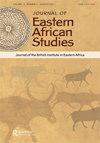作为“示范田”的农业走廊:莫桑比克贝拉和纳卡拉走廊沿线的基础设施、博览会和协会
IF 0.6
3区 社会学
Q2 AREA STUDIES
引用次数: 10
摘要
摘要在过去的十年里,莫桑比克政府一直在动员国际资本,在该国中部和北部地区建设和翻新交通基础设施,目的是建立农业走廊。根据在贝拉和纳卡拉走廊沿线两个地区进行的实地研究,我考察了国际资本和国家农业政策在实施农业项目时与小农户会面的情况。本文对农业走廊的构成进行了实证分析。我认为,当国际资助者和投资者、国家精英、地方官僚和小农户夸大农业项目的成功,并构成我所说的“示范田”时,就会出现农业走廊。无论蓝图的实施情况如何,农业走廊都会从成功展示农业项目的表现中获得空间和时间的重要性,例如在农业相关基础设施的揭幕仪式上、在农业博览会上以及在小农户协会参与的场合。本文章由计算机程序翻译,如有差异,请以英文原文为准。
Agricultural corridors as ‘demonstration fields’: infrastructure, fairs and associations along the Beira and Nacala corridors of Mozambique
ABSTRACT In the past decade, the Mozambican government has been mobilizing international capital to build and renovate transport infrastructure in the central and northern areas of the country, with the aim of creating agricultural corridors. Based on field research conducted in two districts along the Beira and Nacala corridors, I examine those occasions when international capital and national agricultural policy meet smallholders in the implementation of agricultural projects. This article offers a performative analysis of the constitution of agricultural corridors. I argue that agricultural corridors emerge on those occasions when international funders and investors, national elites, local bureaucrats and smallholders overstate the success of agricultural projects and constitute what I have termed ‘demonstration fields’. Regardless of the implementation of blueprints, agricultural corridors gain spatial and temporal materiality from the performance of presenting agricultural projects as successful, such as at the unveiling of agro-related infrastructure, at agricultural fairs and on occasions involving smallholders’ associations.
求助全文
通过发布文献求助,成功后即可免费获取论文全文。
去求助
来源期刊

Journal of Eastern African Studies
AREA STUDIES-
CiteScore
3.30
自引率
7.10%
发文量
12
期刊介绍:
Journal of Eastern African Studies is an international publication of the British Institute in Eastern Africa, published four times each year. It aims to promote fresh scholarly enquiry on the region from within the humanities and the social sciences, and to encourage work that communicates across disciplinary boundaries. It seeks to foster inter-disciplinary analysis, strong comparative perspectives, and research employing the most significant theoretical or methodological approaches for the region.
 求助内容:
求助内容: 应助结果提醒方式:
应助结果提醒方式:


